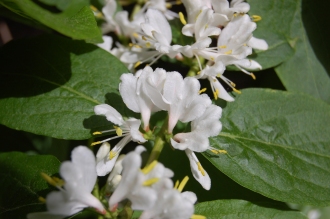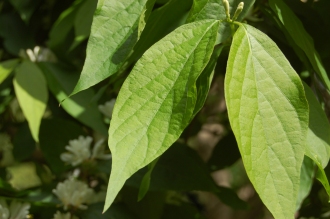Position: Full sun to full shade
Flowering period: Spring to early summer
Soil: Moist, well drained
Eventual Height: 6m
Eventual Spread: 6m
Hardiness: 3a, 3b, 4a, 4b, 5a, 5b, 6a, 6b, 7a, 7b, 8a, 8b
Family: Caprifoliaceae
Lonicera maackii is a deciduous shrub with a bushy habit. Its mid green leaves leaves are ovate to lanceolate with an entire margin, up to 9cm long and 4cm broad. Its cream to yellow fragrant flowers are tubular, up to 2cm long, produced in pairs, and appeared in clusters. Its bright red/ black fruit are spherical and up to 6mm across.
Lonicera maackii, commonly known as Amur Honeysuckle or Bush Honeysuckle, is native to north and west China, Japan, Korea, Mongolia and south Russia. It has naturalised in New Zealand and east USA as this plant is readily dispersed by bird who eat its seed. It is considered an invasive species and is controlled in a number of states in the USA.
The etymological root of the binomial name Lonicera is derived from the name of Adam Lonicer, a German naturalist from the 16th century. Maackii is derived from the name of Richard Maack (1825 – 1886), a Russian naturalist.
The landscape architect may find Lonicera maackii useful as a woodland understory plant. It also forms an effective hedge when clipped. Once established this shrub is drought tollerant.
Ecologically, Lonicera maackii flowers are attractive to pollinating insects. Its seeds are attractive to birds.
Lonicera maackii prefers moist, fertile, well-drained soils. It tolerates most pH of soil.
Lonicera maackii requires little maintenance. If maintaining as a hedge, pruning should be carried out after flowering.








i’m too far south for this one now (zone 10a) but it figures prominently in every summer memory from my youth. My cousins’ house–where we’d spend every Sunday…remember those days of big family dinners?–was flanked by these wildly fragrant shrubs. We were let stay out later on Sundays and as twilight approached their fragrance eally ratchetted up! Everytime I catch a scent of honeysuckle I’m immediately back in the 1960s yard!!
this tree blows. fuck this tree. invasive as hell and destroys native areas.
Colin, our article does mention that this tree can be invasive and is controlled in a number of states in USA. I can only assume from your response that you live in one of the controlled states. I welcome the fact that you have taken the time to comment, but in the future, can I please ask you to moderate your language.